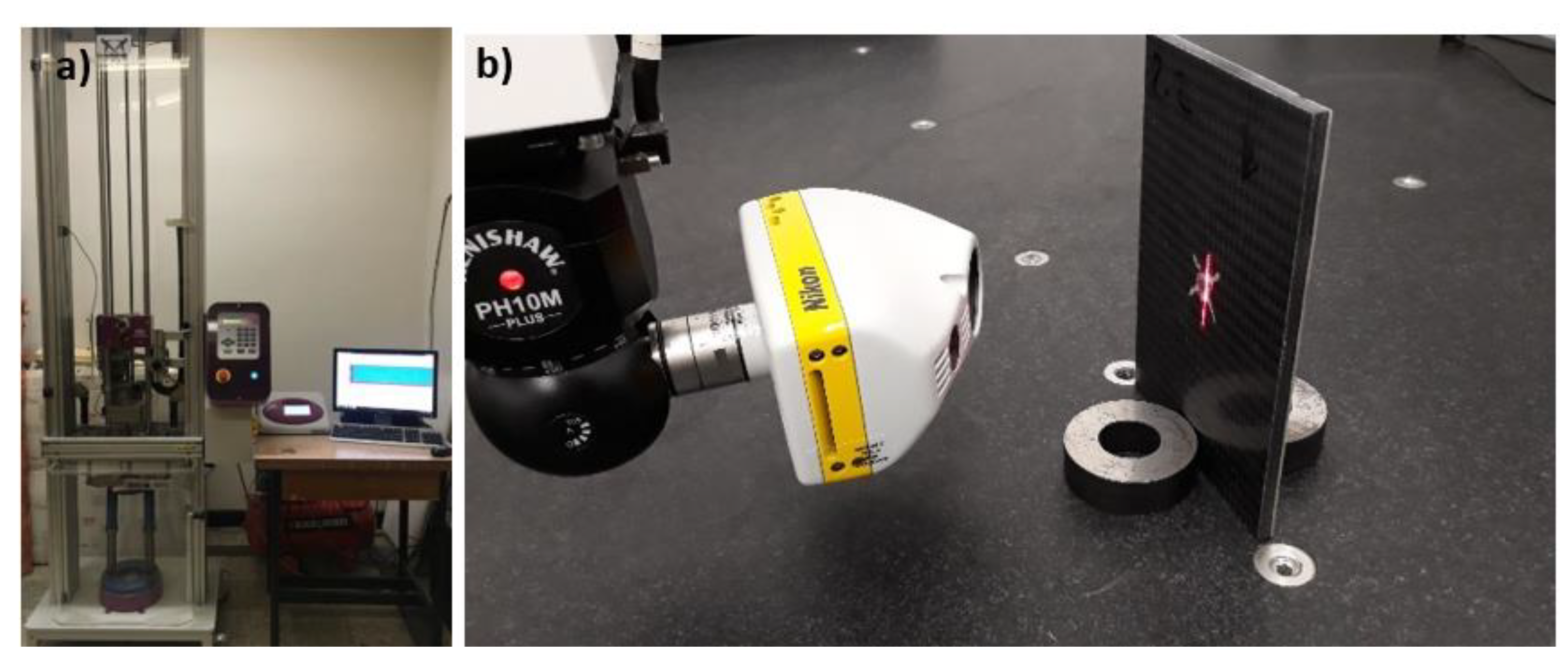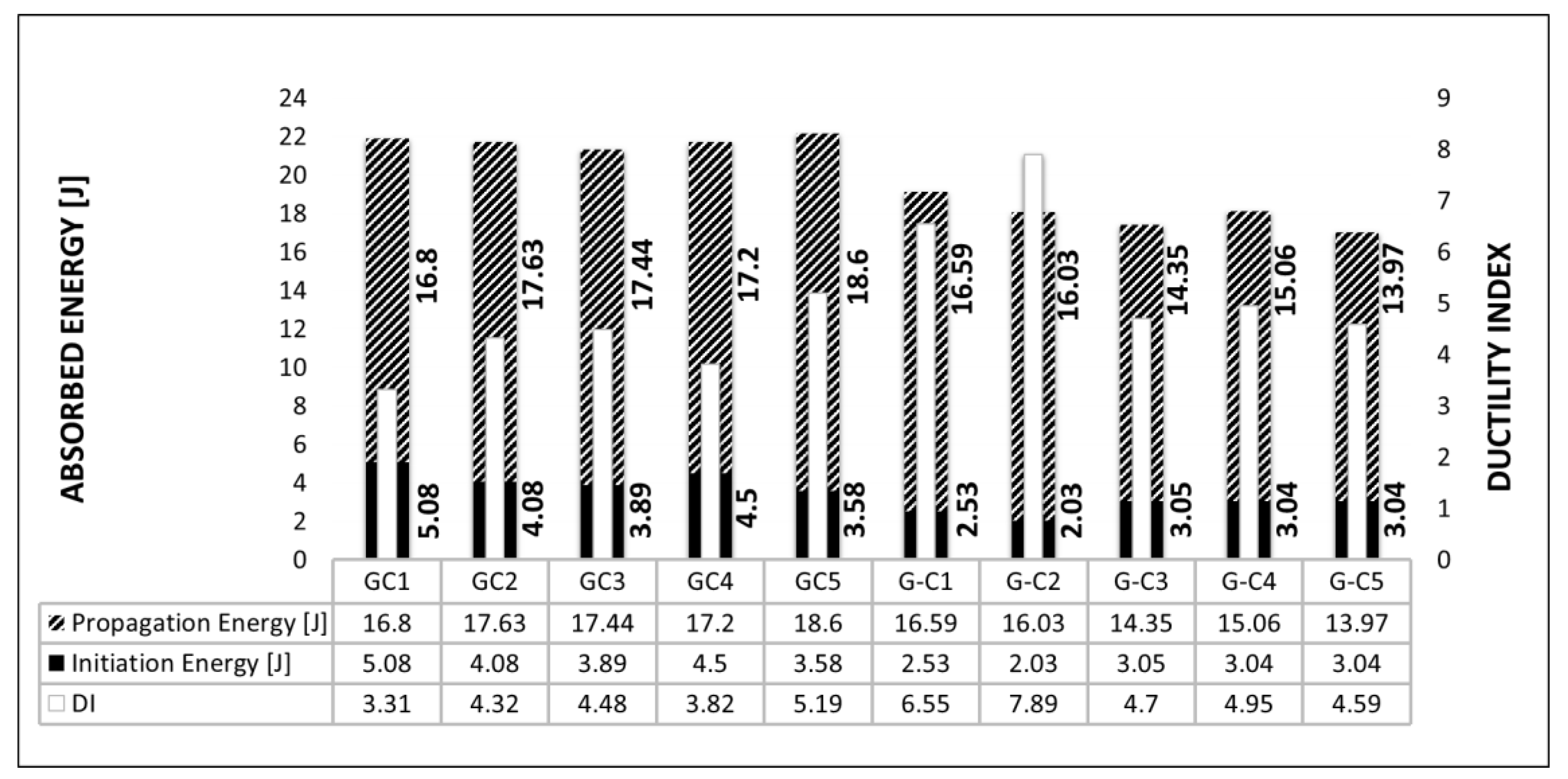Investigation on Layer Hybridization of Glass/Carbon Fibre Woven Reinforced Composites Subjected to Low-Speed Impact
Abstract
1. Introduction
2. Materials and Methods
Drop-Weight Impact Testing and Evaluation Methods
3. Results
3.1. Low-Velocity Impact Response
- is the absorbed energy at time t corresponding to the end of the test, J;
- is the initial impact velocity, [m/s];
- is the impact velocity at time t corresponding to the end of the test, [m/s];
- m is the mass of the impactor, [kg];
- g is the acceleration due to gravity, 9.81, [m/s2];
- is the impactor displacement at time t corresponding to the end of the test, [m].
3.2. Damage Analysis and Morphologies
4. Conclusions
Author Contributions
Funding
Institutional Review Board Statement
Informed Consent Statement
Data Availability Statement
Conflicts of Interest
References
- Alves, M.; Chaves, C.; Birch, R. Impact on aircraft. In Proceedings of the 17th International Congress of Mechanical Engineering, Sao Paulo, Brazil, 10–14 November 2003. [Google Scholar]
- Swolfs, Y.; Meerten, Y.; Hine, P.; Ward, I.; Verpoest, I.; Gorbatikh, L. Introducing ductility in hybrid carbon fibre/self-reinforced composites through control of the damage mechanisms. Compos. Struct. 2015, 131, 259–265. [Google Scholar] [CrossRef]
- Yadav, S.N.; Kumar, V.; Verma, S.K. Fracture toughness behaviour of carbon fiber epoxy composite with Kevlar reinforced interleave. Mater. Sci. Eng. 2006, 132, 108–112. [Google Scholar] [CrossRef]
- Aksoy, A.; Carlsson, L.A. Interlaminar shear fracture of interleaved graphite/epoxy composites. Compos. Sci. Technol. 1992, 43, 55–69. [Google Scholar] [CrossRef]
- Sathishkumar, T.P.; Naveen, J.; Satheeshkumar, S. Hybrid fiber reinforced polymer composites—A review. J. Reinforc. Plast. Compos. 2014, 33, 454–471. [Google Scholar] [CrossRef]
- Mittal, R.K.; Jafri, M.S. Influence of fiber content and impactor parameter on transvers impact response of uniaxially reinforced composite plates. Composites 1995, 26, 877–886. [Google Scholar] [CrossRef]
- Razali, N.; Sultan MT, H.; Mustapha, F.; Yidris, N.; Ishak, M.R. Impact Damage on Composite Structures—A Review. Int. J. Eng. Sci. 2014, 3, 8. [Google Scholar]
- Impact Testing of Composite Materials, by Dr. Donald, F. Adams. Available online: http://www.compositesworld.com/articles/impact-testing-of-composite-materials (accessed on 16 May 2022).
- Babu, S.; Shivanand, H.K. Impact Analysis of Laminated Composite on Glass Fiber and Carbon Fiber. Int. J. Emerg. Technol. Adv. Eng. 2014, 4, 824. [Google Scholar]
- Isa, M.T.; Ahmed, A.S.; Aderemi, B.O.; Taib, R.M.; Akil, H.M.; Mohammed-Dabo, I.A. Drop Weight Impact Studies of Woven Fibers Reinforced Modified Polyester Composites. Leonardo Electron. J. Pract. Technol. 2014, 24, 97–112. [Google Scholar]
- Jang, B.Z.; Chen, L.C.; Wang, C.Z.; Lin, H.T.; Zee, R.H. Impact resistance and energy absorption mechanisms in hybrid composites. Compos. Sci. Technol. 1989, 34, 305–335. [Google Scholar] [CrossRef]
- Park, R.; Jang, J. Stacking sequence effect of aramid- UHMWPE hybrid composites by flexural test method. Polym. Test. 1997, 16, 549–562. [Google Scholar] [CrossRef]
- Karahan, M.; Karahan, N. Effect of weaving structure and hybridization on the low-velocity impact behavior of woven carbon-epoxy composites. Fibers Text. East Eur. 2014, 22, 109–115. [Google Scholar]
- Zhang, D.; Sun, Y.; Chen, L.; Pan, N. A comparative study on low-velocity impact response of fabric composite laminates. Mater Des. 2013, 50, 750–756. [Google Scholar] [CrossRef]
- Naik, N.K.; Ramasimha, R.; Arya HE ME ND, R.A.; Prabhu, S.V.; ShamaRao, N. Impact response and damage tolerance characteristics of glass-carbon/ epoxy hybrid composite plates. Compos. Part B Eng. 2001, 32, 565–574. [Google Scholar] [CrossRef]
- Hosur, M.V.; Adbullah, M.; Jeelani, S. Studies on the low velocity impact response of woven hybrid composites. Compos. Struct. 2005, 67, 253–262. [Google Scholar] [CrossRef]
- Shukla, M.J.; Kumar, D.S.; Mahato, K.K.; Rathore, D.K.; Prusty, R.K.; Ray, B.C. A comparative study of the mechanical performance of Glass and Glass/Carbon hybrid polymer composites at different temperature environments. In 4th National Conference on Processing and Characterization of Materials; IOP Conference Series: Materials Science and Engineering; IOP Publishing Ltd.: Bristol, UK, 2015; Volume 75, p. 012002. [Google Scholar]
- Vieille, B.; Casado, V.M.; Bouvet, C. About the impact behavior of woven-ply carbon fibre reinforced thermoplastic- and thermosetting-composites: A comparative study. Compos. Struct. 2013, 101, 9–21. [Google Scholar] [CrossRef]
- Dhakal, H.N.; Zhang, Z.Y.; Richardson, M.O.W.; Errajhi, O.A.Z. The low velocity impact response of non-woven hemp fibre reinforced unsaturated polyester composites. Compos. Struct. 2007, 81, 559–567. [Google Scholar] [CrossRef]
- Safri, S.N.A.; Sultan, M.T.H.; Cardona, F. Impact Damage Evaluation Of Glass-Fiber Reinforced Polymer (GFRP) Using The Drop Test Rig—An Experimental Based Approach. ARPN J. Eng. Appl. Sci. 2015, 10, 9916–9928. [Google Scholar]
- Mitrevski, T.; Marshall, I.H.; Thomson, R. The influence of impactor shape on the damage to composite laminates. Compos. Struct. 2006, 76, 116–122. [Google Scholar] [CrossRef]
- Sutherland, L.S.; Soares, C.G. Impact characterisarion of low fibre-volume glass reinforced polyester circular laminated plates. Int. J. Impact. Eng. 2005, 31, 1–23. [Google Scholar] [CrossRef]
- Sutherland, L.S.; Soares, C.G. Impact on low fibre volume, glass/polyester rectangular plates. Compos. Struct. 2005, 68, 13–22. [Google Scholar] [CrossRef]
- Richardson, M.O.W.; Wisheart, M.J. Review of low velocity impact properties of composite materials. Compos. Part A Appl. Sci. Manuf. 1996, 27, 1123–1131. [Google Scholar] [CrossRef]
- Ying, S.; Mengyun, T.; Zhijun, R.; Baohui, S.; Li, C. An experimental investigation on the low-velocity impact response of carbon–aramid/epoxy hybrid composite laminates. J. Reinf. Plast. Compos. 2017, 36, 422–434. [Google Scholar] [CrossRef]
- Evensen, T.; Mahinfalah, M.; Jarzar, R.N.; Berg, J.M. Effect of Gas Plasma Surface Treatment on Spectra 900 and Spectra 1000 Fabric Laminates composites. In Proceedings of the 16th International Conference on Composite Materials, Kyoto, Japan, 8–13 July 2007; pp. 1–9. [Google Scholar]









| Specimen/ Configuration | Hybrid Structure 16 Plies | Architectural Hybridization |
|---|---|---|
| GC | [+45G/−45C/0G/90C]4s | ■□■□■□■□■□■□■□■□ |
| G-C | [+45G/−45G/0G/90G/+45C/−45C/0C/90C]2s | ■■■■□□□□■■■■□□□□ |
| Config. | Fm [kN] | Fm [kN] Mean Value | Ei [J] | Ei [J] Mean Value | Ep [J] | Ep [J] Mean Value | Ea [J] | Ea [J] Mean Value | DI | DI Mean Value |
|---|---|---|---|---|---|---|---|---|---|---|
| GC1 | 10.35 | 10.25 | 5.08 | 4.22 | 16.80 | 17.53 | 21.88 | 21.65 | 3.31 | 4.22 |
| GC2 | 10.62 | 4.08 | 17.63 | 21.71 | 4.32 | |||||
| GC3 | 10.37 | 3.89 | 17.44 | 21.33 | 4.48 | |||||
| GC4 | 10.05 | 4.5 | 17.20 | 21.70 | 3.82 | |||||
| GC5 | 9.89 | 3.58 | 18.60 | 21.64 | 5.19 | |||||
| G-C1 | 10.46 | 10.41 | 2.53 | 2.73 | 16.59 | 15.20 | 19.12 | 17.93 | 6.55 | 5.73 |
| G-C2 | 10.38 | 2.03 | 16.03 | 18.06 | 7.89 | |||||
| G-C3 | 10.30 | 3.05 | 14.35 | 17.4 | 4.70 | |||||
| G-C4 | 10.38 | 3.04 | 15.06 | 18.1 | 4.95 | |||||
| G-C5 | 10.56 | 3.04 | 13.97 | 17.01 | 4.59 |
Disclaimer/Publisher’s Note: The statements, opinions and data contained in all publications are solely those of the individual author(s) and contributor(s) and not of MDPI and/or the editor(s). MDPI and/or the editor(s) disclaim responsibility for any injury to people or property resulting from any ideas, methods, instructions or products referred to in the content. |
© 2023 by the authors. Licensee MDPI, Basel, Switzerland. This article is an open access article distributed under the terms and conditions of the Creative Commons Attribution (CC BY) license (https://creativecommons.org/licenses/by/4.0/).
Share and Cite
Maier, R.; Mandoc, A.-C. Investigation on Layer Hybridization of Glass/Carbon Fibre Woven Reinforced Composites Subjected to Low-Speed Impact. J. Compos. Sci. 2023, 7, 83. https://doi.org/10.3390/jcs7020083
Maier R, Mandoc A-C. Investigation on Layer Hybridization of Glass/Carbon Fibre Woven Reinforced Composites Subjected to Low-Speed Impact. Journal of Composites Science. 2023; 7(2):83. https://doi.org/10.3390/jcs7020083
Chicago/Turabian StyleMaier, Raluca, and Andrei-Cristian Mandoc. 2023. "Investigation on Layer Hybridization of Glass/Carbon Fibre Woven Reinforced Composites Subjected to Low-Speed Impact" Journal of Composites Science 7, no. 2: 83. https://doi.org/10.3390/jcs7020083
APA StyleMaier, R., & Mandoc, A.-C. (2023). Investigation on Layer Hybridization of Glass/Carbon Fibre Woven Reinforced Composites Subjected to Low-Speed Impact. Journal of Composites Science, 7(2), 83. https://doi.org/10.3390/jcs7020083






